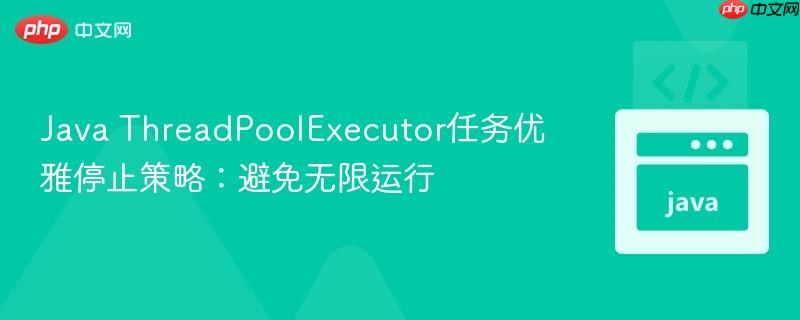
本文探讨了在使用java `threadpoolexecutor`时,任务无法正确停止的常见问题。通过分析错误的线程中断机制,特别是当`runnable`任务被线程池执行时,`thread.currentthread().interrupt()`的误用。文章提出并演示了使用`volatile`布尔标志作为一种安全、高效的机制,以实现任务的优雅终止,并提供了示例代码和最佳实践,确保线程池任务能够按预期停止。
在使用Java的并发API时,ExecutorService(通常通过ThreadPoolExecutor实现)是管理和执行异步任务的核心工具。当我们向ExecutorService提交一个Runnable任务时,线程池会从其内部维护的线程池中分配一个工作线程来执行该Runnable的 run()方法。这意味着,Runnable实例本身并不是一个线程,它只是一个任务的定义,实际执行任务的是线程池中的某个工作线程。
任务的终止通常有两种方式:
在处理长时间运行或无限循环的任务时,如果没有正确的取消机制,任务可能会导致线程池无法关闭,程序持续运行。一个常见的错误模式是在Runnable实现中错误地使用线程中断。
考虑以下一个生成素数的PrimeProducer任务,它被提交给ExecutorService:
立即学习“Java免费学习笔记(深入)”;
import java.math.BigInteger;
import java.util.concurrent.ArrayBlockingQueue;
import java.util.concurrent.BlockingQueue;
import java.util.concurrent.ExecutorService;
import java.util.concurrent.Executors;
// 原始的PrimeProducer实现,存在问题
public class PrimeProducer implements Runnable {
private final BlockingQueue<BigInteger> queue;
PrimeProducer(BlockingQueue<BigInteger> queue) {
this.queue = queue;
}
@Override
public void run() {
try {
BigInteger p = BigInteger.ONE;
// 期望通过中断停止循环
while (!Thread.currentThread().isInterrupted()) {
queue.put(p = p.nextProbablePrime());
}
} catch (InterruptedException e) {
// 捕获中断异常,通常在此处清理资源或退出
System.out.println("PrimeProducer interrupted.");
}
}
// 尝试取消任务的方法
public void cancel() {
// 错误:这里中断的是调用cancel()方法的线程,而不是执行run()的工作线程
Thread.currentThread().interrupt();
}
public void get() {
for (BigInteger i : queue) {
System.out.println(i.toString());
}
}
public static void main(String[] args) {
PrimeProducer generator = new PrimeProducer(new ArrayBlockingQueue<>(10));
ExecutorService exec = Executors.newFixedThreadPool(1);
exec.execute(generator); // 任务由线程池的工作线程执行
try {
Thread.sleep(1000); // 运行1秒
} catch (InterruptedException e) {
Thread.currentThread().interrupt(); // 重新中断当前线程
} finally {
generator.cancel(); // 尝试取消任务
}
exec.shutdown(); // 关闭线程池
System.out.println("Main thread exiting.");
}
}上述代码中存在两个关键问题:
当exec.shutdown()被调用时,它会尝试优雅地关闭线程池,包括向池中的工作线程发送中断信号。此时,工作线程的isInterrupted()状态才会被设置为true,或者queue.put()等阻塞操作会抛出InterruptedException,从而使任务最终停止。但在shutdown()生效之前,程序可能已经因为任务无法响应外部取消而长时间运行。
为了实现任务的可靠和优雅终止,尤其是在Runnable任务被线程池执行时,推荐使用一个volatile布尔标志。
volatile关键字确保了变量在多线程间的可见性。当一个线程修改了volatile变量的值,其他线程能够立即看到这个新值,从而避免了因缓存不一致导致的问题。
以下是使用volatile标志改进后的PrimeProducer实现:
import java.math.BigInteger;
import java.util.concurrent.ArrayBlockingQueue;
import java.util.concurrent.BlockingQueue;
import java.util.concurrent.ExecutorService;
import java.util.concurrent.Executors;
import java.util.concurrent.TimeUnit; // 引入TimeUnit
public class PrimeProducer implements Runnable {
private final BlockingQueue<BigInteger> queue;
private volatile boolean cancelled; // 使用volatile标志
PrimeProducer(BlockingQueue<BigInteger> queue) {
this.queue = queue;
}
@Override
public void run() {
try {
BigInteger p = BigInteger.ONE;
// 循环检查cancelled标志
while (!cancelled) {
// 如果任务被取消,且put操作阻塞,InterruptedException会抛出
queue.put(p = p.nextProbablePrime());
}
} catch (InterruptedException e) {
// 当put操作因线程中断而抛出异常时,任务可以终止
System.out.println("PrimeProducer interrupted during put operation.");
} finally {
System.out.println("PrimeProducer stopped.");
}
}
// 设置取消标志
public void cancel() {
cancelled = true;
}
public void get() {
for (BigInteger i : queue) {
System.out.println(i.toString());
}
}
public static void main(String[] args) {
PrimeProducer generator = new PrimeProducer(new ArrayBlockingQueue<>(10));
ExecutorService exec = Executors.newFixedThreadPool(1);
exec.execute(generator);
try {
Thread.sleep(1000); // 运行1秒
} catch (InterruptedException e) {
System.out.println("Main thread interrupted.");
Thread.currentThread().interrupt();
} finally {
generator.cancel(); // 设置取消标志
System.out.println("Cancellation signal sent.");
}
// 尝试优雅关闭线程池,等待任务完成,最多等待5秒
exec.shutdown();
try {
if (!exec.awaitTermination(5, TimeUnit.SECONDS)) {
System.out.println("ThreadPool did not terminate in time, forcing shutdown...");
exec.shutdownNow(); // 强制关闭
}
} catch (InterruptedException e) {
System.out.println("Awaiting termination interrupted.");
exec.shutdownNow();
Thread.currentThread().interrupt();
}
System.out.println("Main thread exiting.");
}
}在这个改进方案中:
正确地终止ThreadPoolExecutor中的任务是并发编程中的一个重要方面。当任务由线程池的工作线程执行时,直接通过Thread.currentThread().interrupt()从外部调用来中断任务是无效的,因为它中断的是调用cancel()方法的线程,而非执行任务的工作线程。
通过引入一个volatile布尔标志,并在任务的run()方法中检查该标志,可以实现任务的优雅和响应式取消。结合对InterruptedException的适当处理以及ExecutorService的shutdown()和awaitTermination()机制,可以构建出健壮且易于管理的并发应用程序。这种模式确保了即使在长时间运行的任务中,程序也能根据外部信号及时停止,避免资源泄露和程序无限期运行的问题。
以上就是Java ThreadPoolExecutor任务优雅停止策略:避免无限运行的详细内容,更多请关注php中文网其它相关文章!

每个人都需要一台速度更快、更稳定的 PC。随着时间的推移,垃圾文件、旧注册表数据和不必要的后台进程会占用资源并降低性能。幸运的是,许多工具可以让 Windows 保持平稳运行。

Copyright 2014-2025 https://www.php.cn/ All Rights Reserved | php.cn | 湘ICP备2023035733号